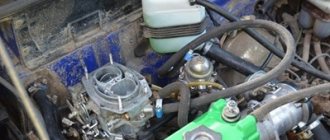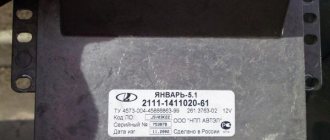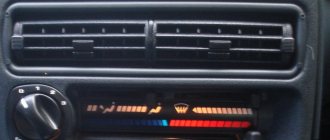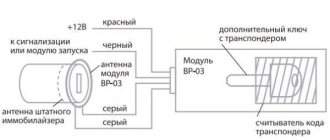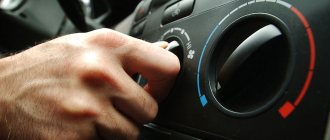The problem of difficulty starting the engine can manifest itself both when it is cold and after the engine has completely warmed up and reached operating temperatures. A common situation is that a hot petrol or diesel engine does not start after a short period of parking.
We also recommend reading the article about the design of the carburetor. From this article you will learn about the components and operating principles of this mixture formation device.
Typical reasons for difficulty starting a carburetor car
If the car suddenly does not start when hot, then with a skillful approach the problem can be solved.
However, this situation will continue as long as the motor is running. If the car is stopped, the temperature of the carburetor will begin to rise due to the fairly hot engine body. At this moment there are no longer any air flows, so it will not cool. The gasoline remaining in the float chamber will evaporate very rapidly as temperatures rise.
Fuel vapors will fill any cavities they can reach. This could be the intake manifold, the carburetor itself, the air filter and other parts. The levels of fuel remaining in the float chamber will drop below their normal level, and sometimes so-called gas locks may form in the power system.
How long this process will last depends entirely on how the fuel system of a particular car is designed, on the temperature of the engine and on the outside temperature. Other factors may also affect the duration. So, this effect can last for 5 minutes or 30 minutes.
If during these processes the driver suddenly wants to start the car, then due to the huge volume of fuel vapors that have accumulated in the cavities of the intake manifold, a too rich fuel mixture will enter the cylinders. This is the main reason why the engine does not start when it is hot.
Possible faults
No matter how trivial it may sound, if the injector does not start, it means something has gone wrong. The success and speed of repair depends on how quickly and efficiently the problematic link in the car’s design can be identified. To better understand the essence of repair activities, it would be a good idea to pay attention to potential breakdowns. The basic list of the latter is as follows:
- Malfunctions of the injector itself. In the event of a breakdown of this kind, as a rule, the car does not start either cold or hot. On top of that, the injector indicator on the dashboard or on-board computer constantly lights up, signaling its malfunction. It is much less common for the engine to work when the indicator is on, but in this case the car starts poorly and is extremely unstable. It is worth noting that the injectors in the injector most often become clogged or the ECU burns out, so it is advisable to check these components first;
- Ignition system failures. Here the list of possible faults is quite large. Often the candles that suffer are simply flooded. In the event of such a breakdown, the car starts and immediately stalls, but in the long term it stops even “grasping.” Other components of the ignition system (coil, module, distributor, crankshaft sensor, etc.) are noticeably less likely to suffer;
- Incorrect operation of the fuel system. In this aspect, injection engines most often suffer on three fronts:
- Fuel filters are clogged (the car “picks up”, but does not start; if the engine starts, it is extremely unstable);
- The fuel pump is faulty (its characteristic operating sound is absent when you turn the ignition key, the injector itself simply does not start both cold and hot, the starter turns).
- There is insufficient pressure in the fuel system (the engine starts up reluctantly both cold and hot, but if it starts working, it functions unstable);
- Engine problems. Perhaps the widest range of possible malfunctions. Often the reason lies in weak compression or incorrectly adjusted valves. In any case, with a “motor” starting problem, high-quality engine diagnostics are required, otherwise it will be very difficult to determine the cause of the malfunction.
In addition to the breakdowns described above that can break the operation of the injector, the problem may lie in more trivial things. An example of this is a weak battery charge or lack of fuel in the tank. Considering just such incidents, before repairing a car, it is extremely important to exclude the possibility of their occurrence, so as not to waste extra time and nerves.
Hot engine stops
This is another very unpleasant moment. It is especially typical for the domestic automobile industry of older model years. If the engine suddenly overheats, it suddenly just stops. This often happens in hot summers.
Among the popular reasons is a gas lock in the fuel pump. These plugs prevent the pump from functioning normally and the float chamber is dry. The combustible mixture simply does not get there. In this case, only cooling the pump will help. It is watered with water.
You should be careful with these devices. The pump housing may contain glass parts.
Carburetor
So, if you have a carburetor engine and it doesn’t start well when hot. then you need to determine what the problem is. There can be only two problems here, and both of them are related to fuel. In the first case, there may be problems with fuel. This often happens when the driver refueled at another gas station, where he had never refueled before. The second reason is the carburetor, or rather its settings.
The main problem why a carburetor engine does not start when hot is that the engine has a high temperature during operation relative to the carburetor. When the engine is started and requires fuel from the carburetor, then everything is fine, the fuel circulates and cools the carburetor and the engine.
But when it shuts down after running for a long time, the engine transfers its heat to the carburetor and it heats up. At this moment, the gasoline that was pumped into the carburetor begins to evaporate, and air plugs begin to form in the system, which prevent the car from starting.
DETAILS: Do I need to flush the engine when changing the oil?
In order to avoid this problem, you need to lean the fuel mixture yourself. This means that the fuel mixture will now contain more air than gasoline. This can be done using the gas pedal. In order to lean the fuel mixture, you need to press the gas pedal.
The third problem, due to which it may be difficult to start when hot, in an engine where the carburetor is responsible for fuel injection, is that the gasoline pump in the tank is faulty or overheated. The problem is that previously gasoline pumps could not work at high temperatures, and during operation they often became unusable or simply turned off, which prevented the car from starting.
In this case, you should simply replace the gasoline pump with a more modern one. Recently, fuel supply pumps have been able to operate in almost any weather and without interruption. The price for such pumps is slightly higher than for a standard carburetor from a Volga car manufacturer.
A warm carburetor engine may have difficulty starting due to a number of design features of the carburetor itself. Also, if you have this device, you must take into account the fact that gasoline has certain properties that additionally affect the start of a hot engine with a carburetor.
A carburetor car may not start hot due to the fact that when the internal combustion engine is running, the carburetor is cooled by air that passes through this mixture formation device. It turns out that while the engine is running, the carburetor does not heat up as much as the engine. After stopping the engine, cooling stops, and the carburetor heats up more in the engine compartment.
With such heating, gasoline, which tends to evaporate under the influence of high temperature, simply evaporates from the float chamber. The result is the formation of air pockets in the fuel supply system, which complicate the subsequent “hot” start of the engine.
To do this, the gas pedal is depressed by ½ stroke or to the floor on some internal combustion engines. The pedal is pressed only once. With several presses of the accelerator, the risk of completely filling the spark plugs increases even more. As for AvtoVAZ products, the fuel pump is also a common reason why a hot engine will not start. The fact is that simple overheating causes malfunctions of the device.
When starting the engine, you have to turn the starter for a long time. What is the reason?
Main reasons
- Worn brushes in the starter. The malfunction is typical for used cars. You will need to remove the starter cover and replace the two brushes;
- Debris accumulation in the fuel tank. Garbage gets into the tank along with gasoline. These unwanted particles enter the fine filter and clog it. Accordingly, less fuel enters the combustion chamber, which is why you have to turn the starter longer.
- The air filter is clogged. Over time, the air filter can also become clogged. This leads to a lack of clean air for fuel.
- Vehicle age. Over time, compression in the cylinders may decrease. Due to low compression, gases leak into the crankcase and the engine cannot be started. This cannot be done without removing and overhauling the engine.
- Old spark plugs.
Is it possible to crank the starter for a long time?
Yes, you can do this, but be prepared for the following problems:
- Dead battery. Each unsuccessful attempt to start reduces the battery charge. In order for the battery to recover the expended energy, you need to start the car and let it run for a while. But if you can’t start, then soon the battery will simply run out. Then you will need to charge it, ask for a light, or try to start it with a pusher.
- Starter failure. Excessive operation of the starter leads to overheating. And this has a very bad effect on its details. Very often they break down, and then you can’t start the car at all. The bendix, which engages with the crankshaft, also suffers. If it fails to start, the splines or bearing may be damaged. So if you turn the starter for a long time, get ready to replace it.
The starter spins for a long time on a carburetor engine.
You can check a carburetor engine using spark plugs. To do this, unscrew them and examine the deposits on the electrodes.
- red color will indicate low-quality fuel. Most likely, it has a high metal content;
- light or black soot appears when the fuel mixture is too lean or rich;
- a slightly brown tint indicates normal engine operation.
The starter spins for a long time on an injection engine
A typical problem with an injection engine, due to which it takes a long time to crank the starter to start the engine, is an error in the on-board computer. This problem can be solved in two ways:
- By reflashing the on-board computer at a service center (or resetting errors);
- Resetting the on-board computer memory by disconnecting the battery. It is necessary to remove the wire from the negative terminal of the battery for 15-20 minutes so that errors are automatically deleted from the memory of the on-board computer, if they were recorded in it.
A warm carburetor engine starts and stalls
If a warmed up and turned on carburetor engine stalls when the sensor has already shown the required operating temperature, then something is really wrong with the vehicle.
Among the reasons for this strange behavior of the vehicle are the following:
- Fuel is of poor quality. This situation is typical when you drive away from a gas station, and after a while the car’s engine begins to “cough” strangely and soon just stalls. What's the solution here? Poor quality fuel should simply be drained, and then the fuel system should be purged and the fuel filter replaced with a new and serviceable one. It is also better to replace the spark plugs if they are already old. If they are new, then it will be enough to simply blow them out. It’s better not to go to such a gas station again. If the receipt has been preserved, you can still go there to make an official complaint regarding the quality of the fuel being sold.
- Generator. If this mechanism is partially or completely broken, then charging the battery will simply stop. The driver may not see this right away, turn on the carburetor and drive off. But after that he will be able to drive only until the battery runs out. Alas, it will no longer be possible to turn on the engine on it again. Sometimes tightening the belt on the alternator you are using can help. If this does not help, then you will need to call a tow truck.
- Fuel filter. If the motor is broken, it is important to check this mechanism. If according to special regulations it is necessary to replace it, this must be done.
- Air filter. The car’s engine can “choke” on the special mixture and quickly stall. It is important to check this element and, if necessary, replace it altogether.
- Gasoline pump. If this mechanism does not work at its full capacity, then the engine will begin to receive less fuel and will soon stall.
It is important to regularly check the functionality of all parts. Even some insignificant breakdowns, if not eliminated on time, can quickly develop into major troubles that will result in complex and expensive repairs for your car.
Injection petrol and diesel engine
Electronic injection systems have a number of components. A malfunction of any element can result in injection gasoline and diesel engines having difficulty starting when hot. The list of possible causes of difficulty starting a hot engine includes:
- coolant temperature sensor;
- mass air flow sensor (MAF, flow meter);
- fuel rail pressure regulator;
- crankshaft position sensor;
- idle air control (IAC);
- problems with the fuel pump;
- fuel injection pump malfunctions in a diesel engine;
- injection nozzles;
- high-voltage armored wires;
- ignition coil, etc.
Sensor malfunctions must be identified using diagnostic equipment. The simplest solutions include a multimeter, which measures the resistance of an electronic device.
Failure of the coolant temperature sensor will mean that an incorrect signal is sent to the engine ECU, as a result of which the optimal fuel supply for starting a hot engine is disrupted. Violation of the tightness of the injection nozzles leads to the fact that the injectors pass gasoline not at the time of fuel injection, but when the nozzle is closed.
The result is a strong enrichment of the fuel-air mixture, flooded spark plugs, etc. The problem is partially reminiscent of the situation with the carburetor. To start a hot engine in this case, it is also necessary to purge by partially or fully opening the throttle. Additionally, it is necessary to check the injector O-rings for integrity and tightness.
Injector problems
Why doesn’t the car start when it’s hot if, for example, it has an injection engine? There are also a lot of problems with such cars, mainly due to sensors, but there are also other problems. There are several options here:
Read also: What to do when you run out of money
- Coolant sensor malfunction. Since the injection system is almost completely automated, its operation depends on the readings of sensors located in the gas tank, engine and other components. As soon as the reading device produces incorrect information, the entire system begins to malfunction. For example, problems in the readings of the coolant sensor lead to the fact that the ECU, which reads the device information, gives the wrong command to other operating elements. As a result, the wrong amount of fuel enters the chamber, which is why it is impossible to create a combustible mixture. The solution to the problem is to disconnect the sensor, clean it, or replace it if it is damaged.
- Problems with injectors. This is an extremely rare case of malfunction, but it does happen. The breakdown consists of a breakdown of the injector, and for this reason fuel is not supplied. The lack of pressure inside the channel leads to the fact that fuel does not enter the combustion chamber. The injectors need to be replaced.
- Faulty air flow sensor. As in the first case, it can easily fail, which disrupts the operation of the system for creating a combustible mixture. As a result, the fuel is either too rich in oxygen, or, conversely, poor. In both cases, fire does not occur, and therefore the engine does not start. The following symptoms accompany the problem: surges in engine power, strange sounds when starting the engine, the sound of a strong exhaust from the gas exhaust system, failures when pressing the gas. Replacing the device and adjusting the entire system should help.
Poor engine starting or starting the second time
Low quality gasoline
There is no common method for assessing fuel quality. You have to use indirect signs, for example, a bad factory after refueling at an untested gas station. At the same time, while your car does not start, there is a high chance of the battery dying, “killing the spark plugs,” clogging the injector, and even destroying the engine in case of improper detonation.
If the engine does not start well when the engine is hot, the reason is probably due to unsuccessful refueling. The solution to this problem is the use of additives in the gas tank that improve the basic characteristics of gasoline.
To protect yourself from the consequences of refueling with low-quality fuel and keep the injector in good condition, we recommend that you always keep on hand the long-term injector cleaner Langzeit Injection Reiniger for gasoline engines and the long-term diesel additive Langzeit Diesel Additiv for diesel engines.
It is recommended to use these fuel additives when refueling at untested gas stations, as well as on highways.
Air filter problems
In winter, when there is a large temperature difference, a possible cause of problems such as icing of the air filter. Lack of air is also a reason that prevents the car from starting. In this case, it is recommended to immediately replace the air filter at the first sign of trouble. The procedure is quite simple and does not require special skills.
IMPORTANT! One of the key factors causing a vehicle to start poorly when cold may be incorrectly selected engine oil. If you fill in oil with a viscosity of 10W-XX and higher, and there is severe frost, the oil thickens and its pumpability in a cold system drops sharply, which leads to significant wear on the engine at start-up; As a result, the car will not start.
In winter, it is important to choose only high-quality oils from trusted manufacturers, as this guarantees that the oils comply with the declared parameters of “behavior” in the cold.
Low spark level
The second, common case is a low level of sparking.
This may happen for the following reasons:
- when spark plugs fail;
- if the electrical connections of the ignition system are broken;
- when the ignition coils fail
In this case, it is necessary to identify the causes and eliminate the source of the malfunction that prevents the vehicle from starting when the engine is cold.
Solution:
It is enough to replace the spark plugs and check all connections of the ignition system.
Fuel pump
Or rather, not only the fuel pump, but also the check valve in the fuel module. The fact is that for safety reasons, the ECU turns off the fuel pump after a couple of seconds if the engine does not rotate. This prevents fuel from leaking during an accident.
Therefore, if the check valve does not work correctly or the pump itself has reduced performance, then it does not have enough time to pump up the necessary pressure to start the engine. And you have to turn on the ignition several times and give the pump more time. Usually the second time the engine starts. Moreover, the colder it is, the more clearly this problem manifests itself, since in warm weather less fuel is required to start and the fuel itself evaporates more easily from the valves, thereby making it easier to start the engine.
In the fuel module, the function of a check valve is performed by the fuel pressure regulator. It maintains fuel pressure within specified limits and prevents fuel from flowing back into the tank when the fuel pump is turned off.
It is installed in the fuel module
Finding it separately is difficult, but possible. You can buy it using this link.
If the pump performance is weak, the pump itself must be replaced (the so-called bulb)
To check and diagnose this reason, it is enough to measure the fuel pressure. How to easily do it yourself is shown here
If the check shows problems with fuel pressure, then do not rush to immediately order a pump or pressure regulator. Remove the fuel module from the vehicle and inspect it. The fact is that sometimes connecting hoses burst and because of this, problems arise with fuel pressure
Crankshaft position sensor.
On vehicles where a camshaft position sensor (CPS) is installed, the engine can operate without a crankshaft position sensor (CPPS).
Therefore, if the DPKV is faulty or gives an incorrect signal, the engine will start anyway. But for this it will need more time, because the ECU needs time to switch to working according to the DPRV.
The most common cause of such problems is contamination of the crankshaft sensor with metal shavings.
Therefore, it is necessary to unscrew the sensor mounting bolt with a 5mm hexagon and pull out the sensor. After this, wipe it thoroughly
The car had problems starting with this sensor. After cleaning the sensor everything returned to normal.
For this reason, after starting the engine, a persistent smell of gasoline may be felt in the exhaust.
Camshaft position sensor
The ECU uses the sensor signal to coordinate fuel injection processes in accordance with the operating order of the cylinders. Based on the signals from the crankshaft and camshaft position sensors, the control unit sets the ignition timing and the cylinder into which fuel should be supplied.
Before the starter starts rotating the engine, the ECU has no idea what position the pistons and valves are in now and where fuel needs to be supplied, since there are no signals from the DPRV and DPKV yet. Therefore, if the DPRV signal is incorrect, the engine will not start the first time.
It is also worth noting that an incorrect DPRV signal is not always due to the fault of the sensor itself. Very often this is due to its wiring and incorrect installation of the sensor. The correct installation of the sensor is written in detail and shown here
For this reason, after starting the engine, a persistent smell of gasoline may be felt in the exhaust.
Air leak
Engine starting depends on the ambient temperature. The lower the temperature, the more air and fuel is needed at startup.
Therefore, before starting, the ECU analyzes the temperature data and, based on these readings, opens the IAC channel for the required number of steps.
At this moment, the ECU does not know about the presence of air leaks past the IAC channel. The control unit only takes values from its memory that at this temperature it is necessary to open the IAC for such and such a time and ensure the injection duration for such and such a time.
Therefore, when starting, we end up with excess air and the engine cannot start. Only after several attempts, when fuel vapors from previous unsuccessful attempts have appeared in the intake manifold and cylinders, will the engine start.
Therefore, in this case it is necessary to check the intake for air leaks. It is usually quite serious, so even a simple smoke generator will show it.
By the way, leaks most often occur through the crankcase ventilation valve and through the gaskets between the intake manifold and the engine.
Canister valve
The adsorber valve opens only when the engine is running. It provides purging of the adsorber, passing fuel vapors into the intake manifold.
If the valve is faulty or leaking, then when the vehicle is parked, fuel vapors can enter the intake manifold and engine cylinders.
Subsequently, when starting, we will get an excess of fuel and the engine either will not start the first time or will start with difficulty.
A distinctive feature of this reason is that after starting, dips in idle speed may be observed. And also a floating idle speed.
Accumulator battery
When it gets colder, many people are faced with starting the engine the second time. Very often the battery is to blame. And don't underestimate its importance.
This is especially true on vehicles with a Sirius ECU.
The starter seems to be turning, but the engine does not start. The whole reason is the voltage drop during startup. An old and weak battery cannot provide a stable potential difference. As long as the engine is warm and easier to start, there are no problems. And as soon as the car sits overnight in cold weather, starting problems cannot be avoided.
Therefore, if your battery is approaching its fifth year, then it’s worth thinking about its fault for poor cold starting.
Personally, I get rid of the battery after seven years of use, even if it is still “alive”.
Additional checks
So, if these methods do not help, then you should check the following components and devices. The first step after the main check is to check the crankshaft position sensor. It may send incorrect signals to the car's electronic control unit, and it will no longer be able to give the correct command to the injectors and other actuators, and the car's engine will not start. Like any other sensor, this one can become clogged or become unusable. The first step is to clean it, and if this does not help, then you need to replace it with a new one.
The second thing to look at is the mass air flow sensor. It is just as important as other sensors in this vehicle system. The mass air flow sensor may be clogged or faulty. It is best to clean the sensor so that it is visually close to new; this is very important in order to determine whether the sensor is working.
The third thing to look at when the car won't start is the fuel line pressure regulator. As the name suggests, it regulates the pressure in the pipes that carry fuel to the injectors.
The fourth explanation why a warm car engine may not start is that the idle speed control is not working. It is needed to ensure proper engine operation during idling.
The fifth reason is high pressure wires. They conduct electric current to the spark plugs, which ignite the fuel mixture in gasoline engines. A faulty high pressure wire can be identified visually. If your high pressure wire has cuts, rips, or other damage, it is best to replace the wire.
If damage is found on one wire, it is best to replace all wires at once. This must be done because most often the wires are installed at the same time, and if one of the wires becomes unusable, the rest will also soon become unusable.
The last thing to look at is the ignition system. In order to find out that the ignition system is faulty, you need to understand a little about the structure of the car. If it is discovered that the fault is in this particular system, it should be replaced immediately.
HBO for cars
A hot engine can also cause a breakdown in the case of an installed gas system. Since driving on gas has recently become profitable, many drivers switched to this type of fuel, however, they did not take into account some of the nuances of the new system. In hot weather, gas expands more, which leads to increased pressure inside the system and often causes damage. This is why it is bad to drive on gas in the heat.
At high temperatures, seals and hoses can fly off, which leads to gas leakage.
The result is an extremely dangerous situation. To avoid this, try not to fill the tank to full gas in the summer, this will reduce the pressure in the system and the risk of breakdown. If a similar problem occurs, it is recommended to let the car cool down and then visit a service station. You should not repair the gas system yourself; the equipment should be adjusted by a specialist.
Diesel
For a diesel engine, the primary cause is the high pressure fuel pump. Often the cause of the malfunction is quite simple - failure of the oil seals and bushings. In this case, routine maintenance of the unit will help. On the other hand, the reason may be hidden in the breakdown of the plunger pair, which actually leads to a major overhaul of the element.
Another element that will affect starting the engine when hot is the temperature sensor of the control injector. Failure of this electronic element will cause a changed injection angle. To fix the problem, you need to replace the sensor.
As for injection engines and diesel power units, a malfunction of the engine control unit disrupts the operation of all systems. To fix the problem, you will have to connect to the motor and carry out repair and diagnostic operations.
Fuel quality
If the car does not start well when it is hot, this may not always be due to breakdowns of any elements. Often the cause may be fuel. Poor quality fuel is one of the most popular reasons. But if the fuel is bad, the car will not start normally even when cold.
Gasoline or diesel fuel can sometimes contain additives that are not needed by the engine and are harmful to it. If diesel is frozen, it turns into jelly, and the pump cannot pump such a mass. It happens that the ECU system adjustments go wrong.
ECU software failure
If the car does not start when hot, but all sensors, spark plugs and wires have been checked, then it is worth diagnosing other components.
Sometimes it happens that the software in the ECU unit fails. To check, they are connected to the diagnostic connector in the car, and using a laptop and diagnostic programs, they detect faults. All that remains is to eliminate them by flashing them.
Let's sum it up
High-quality fuel supply systems rarely fail, so even in the hottest weather, hot cars start without problems. But if such a problem occurs, the driver is unlikely to be able to fix it on his own. There are too many factors of possible breakdowns that are difficult to check without special knowledge and certain tools.
Therefore, in most cases, turning to the experts will be the key to a successful trip in your car in any weather. You need to contact a service station as soon as signs of poor car starting begin to appear in your case. The sooner you come to the master, the easier it will be for him to help you.
- The engine stalls when cold. Why is this and what should I do?
- A selection of useful discussions about why it stalls while driving
- Reasons why a diesel engine does not start when hot
- A selection of useful discussions about why the starter does not turn
Check the brushes
Another reason is worn brushes or starter bushings. When the brushes have more wear than recommended, they can no longer reach the commutator. This may be one of the reasons why it won't start when hot. If the support bushings wear too much, the armature, due to heating, touches the stator, and a short circuit occurs, which can reduce the starter speed. Here, to make a diagnosis, you should ring the anchor using a multimeter. Turn-to-turn short circuits are also checked. The next reason is the wrong set of bushings. When they get hot, they jam. Here you should go through the bushings with a reamer or sand them with sandpaper.
